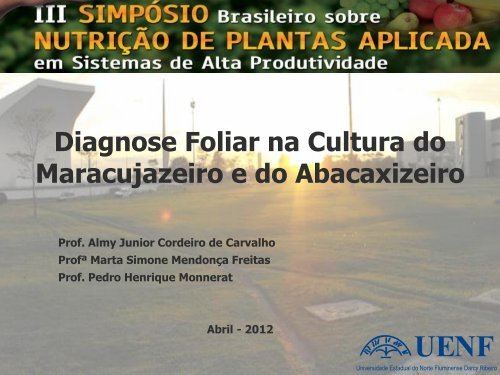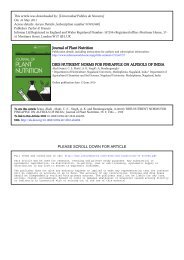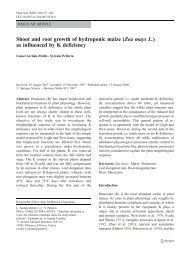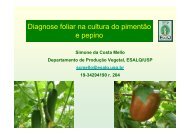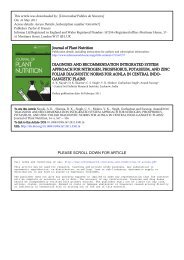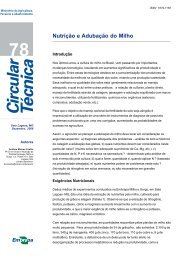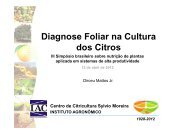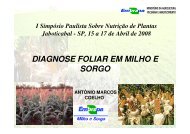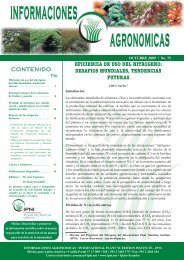Diagnose foliar na cultura do abacaxi e do maracujá - Nutricao de ...
Diagnose foliar na cultura do abacaxi e do maracujá - Nutricao de ...
Diagnose foliar na cultura do abacaxi e do maracujá - Nutricao de ...
You also want an ePaper? Increase the reach of your titles
YUMPU automatically turns print PDFs into web optimized ePapers that Google loves.
<strong>Diagnose</strong> Foliar <strong>na</strong> Cultura <strong>do</strong><br />
Maracujazeiro e <strong>do</strong> Abacaxizeiro<br />
Prof. Almy Junior Cor<strong>de</strong>iro <strong>de</strong> Carvalho<br />
Profª Marta Simone Men<strong>do</strong>nça Freitas<br />
Prof. Pedro Henrique Monnerat<br />
Abril - 2012
APRESENTAÇÃO<br />
• Socieda<strong>de</strong> Brasileira <strong>de</strong> Fruti<strong>cultura</strong><br />
• Produção <strong>de</strong> alimentos e saú<strong>de</strong><br />
• Produção – quantida<strong>de</strong><br />
• Produtivida<strong>de</strong> – eficiência <strong>de</strong> uso <strong>do</strong> solo<br />
• Qualida<strong>de</strong> <strong>do</strong> produto colhi<strong>do</strong> = o objeto da colheita<br />
• Frutiterapia = fruta/saú<strong>de</strong>/prevenção<br />
• Nutrição da planta e produção <strong>de</strong> princípios ativos<br />
• Maracujá – vitexi<strong>na</strong> (flavonoi<strong>de</strong>s)<br />
• Abacaxi – bromeli<strong>na</strong> (enzimas)<br />
• Uva – resveratrol (polifenois)
www.fruti<strong>cultura</strong>.org
Sobre maracujá e <strong>abacaxi</strong><br />
Produção <strong>de</strong> Frutas no Brasil (2010)<br />
(1.000 toneladas)<br />
Citros<br />
20.244 t.<br />
49%<br />
Abacaxi<br />
2.300 t.<br />
6%<br />
Maracujá<br />
920 t.<br />
2%<br />
Uva <strong>de</strong> Mesa<br />
1.351 t.<br />
3%<br />
Ba<strong>na</strong><strong>na</strong><br />
6.962 t.<br />
17%<br />
Mamão<br />
1.871 t.<br />
5%<br />
Coco da Baia<br />
2.837 t.<br />
7%<br />
Manga<br />
1.188 t.<br />
3%<br />
Outros<br />
±2000 t.<br />
5%<br />
Maçã<br />
1.279 t.<br />
3%<br />
Fonte: IBGE (2012) e IBRAF
Área Plantada<br />
Fonte: IBGE (2012)
Produtivida<strong>de</strong><br />
Potencial no maracujazeiro amarelo: + <strong>de</strong> 45 t/ha<br />
Potencial no <strong>abacaxi</strong>zeiro: + <strong>de</strong> 45 mil frutos/ha
Aspectos básicos da diagnose <strong>foliar</strong><br />
avaliação química e visual<br />
Da<strong>do</strong>s obti<strong>do</strong>s <strong>de</strong> populações altamente<br />
produtivas – padrões <strong>de</strong> referência<br />
Normas <strong>de</strong>rivadas <strong>de</strong><br />
experimento<br />
Interessante - Padrão local<br />
Validação
Amostragem<br />
E os erros<br />
Análise <strong>de</strong><br />
Laboratório<br />
Interpretação<br />
<strong>do</strong>s Resulta<strong>do</strong>s<br />
Recomendações
Fatores que <strong>de</strong>vem ser excluí<strong>do</strong>s antes <strong>do</strong> diagnóstico <strong>de</strong><br />
<strong>de</strong>ficiência ou toxi<strong>de</strong>z <strong>de</strong> nutrientes <strong>na</strong>s plantas<br />
Condições ambientais extremas<br />
Aplicação i<strong>na</strong><strong>de</strong>qua<strong>do</strong> <strong>de</strong> produtos ou interação <strong>de</strong><br />
produtos<br />
Ocorrência <strong>de</strong> <strong>do</strong>enças e/ou pragas (dano parte área ou<br />
sistema radicular)<br />
I<strong>na</strong>propriadas condições físicas e/ou químicas <strong>do</strong> solo<br />
Práticas <strong>cultura</strong>is indutoras <strong>de</strong> sintomas <strong>de</strong> anomalias<br />
<strong>na</strong>s plantas<br />
Ocorrência <strong>de</strong> senescência <strong>na</strong>tural <strong>na</strong> folha.
Deficiência ou Toxi<strong>de</strong>z
Amostragem da Planta<br />
Perguntas<br />
Quan<strong>do</strong> <br />
Qual órgão<br />
Quanto<br />
Como Amostrar
Como Amostrar <br />
A amostragem <strong>de</strong> folhas<br />
<strong>de</strong>ve ser realizada por área<br />
homogênea (talhões),<br />
seguin<strong>do</strong>-se o a<strong>do</strong>ta<strong>do</strong> para<br />
amostragem <strong>de</strong> solo
Maracujazeiro: Qual folha amostrar<br />
Cultura Folha da planta a ser amostrada Autores<br />
Maracujazeiro Quarta folha a partir da ponta Malavolta et al. (1997)<br />
Maracujazeiro Folha em todas as posições Cantarutti et al. (2007)<br />
Maracujazeiro 3 ou 4 folha, a partir <strong>do</strong> ápice Pra<strong>do</strong> et al. (2006)<br />
Folha 10<br />
Folha 1<br />
Folhas a serem<br />
amostradas – sem pecíolo Região apical –<br />
elimi<strong>na</strong>da
Teores <strong>de</strong> nutrientes em folhas <strong>de</strong> maracujazeiro<br />
amarelo em função da ida<strong>de</strong><br />
Ida<strong>de</strong> da folha<br />
N P K Ca Mg S Cl Fe Mn B Zn<br />
------------g kg -1 ---------- -----------mg kg -1 ----------<br />
1 (mais nova) 64,9 5,15 22,8 6,34 2,62 4,88 11,3 88,9 42,9 23,2 44,3<br />
2 61,4 4,51 22,7 8,47 2,88 4,68 15,5 95,9 44,9 24,9 39,6<br />
3 58,4 3,95 22,5 10,41 3,11 4,41 19,1 93,0 47,0 26,5 35,4<br />
4 56,0 3,48 22,0 12,14 3,31 4,42 22,1 92,9 49,0 27,8 31,9<br />
5 54,0 3,09 21,3 13,68 3,48 4,45 24,5 95,2 51,0 29,1 28,9<br />
6 52,5 2,80 20,4 15,02 3,62 4,78 26,3 93,6 53,1 30,1 26,5<br />
7 51,5 2,58 19,3 16,17 3,72 4,44 27,5 98,0 55,1 31,0 24,7<br />
8 51,1 2,46 18,0 17,12 3,79 4,30 28,1 96,7 57,1 31,7 23,5<br />
9 51,1 2,41 16,4 17,88 3,83 4,19 28,1 101,9 59,1 32,3 22,8<br />
10 (mais velha) 51,7 2,46 14,7 18,44 3,84 4,07 27,6 102,2 61,2 32,7 22,8<br />
Tukey a 5% 3,3 0,38 4,5 2,86 0,75 1,07 3,1 18,2 19,0 2,6 7,1<br />
Média 55,3 3,29 20,0 13,57 3,42 4,46 23,1 95,8 52,1 28,9 30,0<br />
CV (%) 2,4 4,8 9,2 8,7 9,1 10,0 5,7 7,8 15,3 3,7 9,7<br />
Fonte: Freitas et al. (2007)<br />
Coletar 60 folhas <strong>do</strong> maracujazeiro por ha
Abacaxizeiro<br />
Qual folha amostrar<br />
Folha a ser<br />
amostrada
Amostragem da folha <strong>do</strong> <strong>abacaxi</strong>zeiro<br />
Folha D<br />
Porção clorofilada<br />
Porção aclorofilada<br />
Siebeneichler et al. (2002)
Coletar 25 folhas <strong>do</strong> <strong>abacaxi</strong>zeiro por ha
Maracujazeiro: teores <strong>de</strong> nutrientes <strong>foliar</strong>es<br />
Nutriente<br />
Autores<br />
1 2 3 4 5 6 7 8<br />
-------------------------------------- g kg -1 -------------------------------------<br />
N 36-46 56-59 50-51 44 44 49-60 44-49 35-42<br />
P 2,1-3,0 3,4-3,5 2,9-3,0 3,0 2,8 2,7-3,1 2,46-2,87 2,02-2,57<br />
K 24-32 30-35 26-33 27 33 21-24 18-26 17-25<br />
Ca 17-28 5,5-6,4 10,7-13,8 13 9,9 9,2-14,9 9,6-13,8 8,8-16,6<br />
Mg 2,1 2,9-3,2 4,5-5,6 3,90 3,4 2,7-3,9 3,06-3,92 3,72-4,38<br />
S 4,4 4,4-4,7 4,8-5,2 4,1 3,5 4,0-5,3 4,0-4,8 3,1-3,7<br />
Cl - - - 26 29 19-27 14-23 18-19<br />
--------------------------------------- mg kg -1 ---------------------------------------<br />
Fe 116-233 76-83 94-101 71 89 71-127 72-162 92-181<br />
Mn 433-604 84-97 140-200 86 66 55-139 74-307 55-285<br />
Zn 26-49 33-36 30-34 29 31 25-33 31-39 31-39<br />
Cu 15-16 4,4-4,8 3,9-4,2 4,5 4,3 3,7-5,3 4,0-4,9 3,5-6,4<br />
B 39-47 28-29 65-69 52 43 24-29 22-26 22-34<br />
Ida<strong>de</strong> 250 a 280<br />
dias<br />
Produtivida<strong>de</strong><br />
estimada<br />
360<br />
dias<br />
720<br />
dias<br />
22,1 t ha -1 em 24<br />
meses após o<br />
plantio<br />
360<br />
dias<br />
600<br />
dias<br />
24,5 t ha -1<br />
em 22 meses<br />
após o<br />
plantio -<br />
consorcia<strong>do</strong><br />
com coco<br />
180 a 400<br />
dias<br />
21,7 t ha -1<br />
em 16<br />
meses após<br />
plantio<br />
180 a 540<br />
dias<br />
43 t ha -1 10 t ha -1<br />
1 Haag et al., 1973; 2 Borges et al. (2002); 3 Borges et al. (2002); 4 Rosa (2005); 5 Rosa<br />
(2005); 6 Fontes (2005); 7 Alves (2003); 8 Alves (2003)
Teores <strong>de</strong> nutrientes em folhas maracujazeiro amarelo consi<strong>de</strong>ra<strong>do</strong><br />
<strong>de</strong> alta produtivida<strong>de</strong> e cultiva<strong>do</strong> <strong>na</strong> região Norte Fluminense<br />
Fase fenológica<br />
Nutrientes<br />
Desenvolvimento <strong>de</strong><br />
frutos e baixo<br />
florescimento<br />
Crescimento <strong>de</strong> plantas,<br />
Pleno florescimento e<br />
<strong>de</strong>senvolvimento <strong>de</strong> frutos<br />
Desenvolvimento e<br />
colheita <strong>de</strong> frutos<br />
(janeiro)<br />
(maio)<br />
(outubro)<br />
N (g kg -1 ) 48,1 48,9 39,5<br />
P (g kg -1 ) 3,17 3,31 2,81<br />
K (g kg -1 ) 26,3 24,9 26,5<br />
Ca (g kg -1 ) 10,2 8,41 11,5<br />
Mg (g kg -1 ) 2,31 2,42 3,06<br />
S (g kg -1 ) 3,41 3,56 3,22<br />
Cl (g kg -1 ) 19,6 15,2 23,6<br />
B (mg kg -1 ) 26,9 20,7 51,5<br />
Fe (mg kg -1 ) 109 87 136<br />
Mn (mg kg -1 ) 66,1 51 47<br />
Zn (mg kg -1 ) 26,3 27,8 17,6<br />
Produtivida<strong>de</strong> 36 a 38 t ha -1 ano -1<br />
Carvalho et al. (2011)
Teores médios <strong>de</strong> nutrientes em folhas <strong>do</strong> maracujazeiro amarelo<br />
em diferentes produtivida<strong>de</strong>s, no Norte Fluminense<br />
Escala <strong>de</strong> Produtivida<strong>de</strong> e época <strong>de</strong> amostragem<br />
Nutrientes<br />
< 10 t ha -1 ano -1 > 20 t ha -1 ano -1<br />
maio outubro janeiro maio outubro janeiro<br />
N (g kg -1 ) 40 47,8 37,7 42,5 45,7 43,6<br />
P (g kg -1 ) 2,5 2,75 2,13 2,6 2,79 2,64<br />
K (g kg -1 ) 22,8 30 28,2 19,7 26,9 28,8<br />
Ca (g kg -1 ) 14,7 8,8 8,87 15,5 10,2 10,9<br />
Mg (g kg -1 ) 3 2,5 2,16 3 2,76 2,57<br />
S (g kg -1 ) 3,9 3,9 2,83 4 4 3,6<br />
Cl (g kg -1 ) 25,7 21,8 21,8 23,9 19,9 26,3<br />
B (mg kg -1 ) 41,5 26,8 30,7 34,3 28,1 31<br />
Fe (mg kg -1 ) 119 101 70,4 101 105 74,8<br />
Mn (mg kg -1 ) 67,9 49,4 55,9 78,8 65,8 105<br />
Zn (mg kg -1 ) 28 28,8 27,2 28,8 34,8 38,6<br />
Produtivida<strong>de</strong><br />
8,60 24,0<br />
t ha -1 ano -1<br />
Carvalho et al. (2011)
Fonte: Fontes (2005)
Maracujazeiro <strong>do</strong>ce: teores <strong>de</strong> nutrientes <strong>foliar</strong>es<br />
Autores<br />
Nutrientes<br />
1 2 3 4 5 6<br />
-------------------------------------- g kg -1 -----------------------------------------<br />
N 31,80 37,40 41,60 26,6 33,30 18,2<br />
P 2,19 2,66 3,05 1,91 2,30 0,85<br />
K 22,10 24,80 27,60 12,5 31,30 6,30<br />
Ca 9,00 9,04 7,70 2,80 16,00 7,10<br />
Mg 3,69 3,74 3,92 1,30 4,20 2,00<br />
S 4,01 4,21 4,93 0,67 5,00 1,50<br />
Cl 12,30 15,90 3,89 - - -<br />
------------------------------------- mg kg -1 --------------------------------------<br />
Fe 139,00 68,0 88,40 - 172,00 123,0<br />
Mn 18,40 24,60 40,90 - 21,00 12,0<br />
Zn 30,00 29,80 23,00 - 18,00 14,0<br />
Cu 6,12 4,70 5,39 - 7,67 4,0<br />
B 52,90 39,40 49,00 15,70 57,70 12,7<br />
Mo - - 0,34 - - -<br />
Ida<strong>de</strong> da planta<br />
amostrada após<br />
transplantio<br />
Observações<br />
210 dias 270 dias 310 dias<br />
– planta<br />
sem<br />
<strong>de</strong>ficiência<br />
7,5 kg por planta no<br />
1º ano <strong>de</strong> plantio.<br />
Cultivo em condições<br />
<strong>de</strong> campo<br />
310 dias –<br />
planta com<br />
<strong>de</strong>ficiência<br />
visual<br />
cultivo protegi<strong>do</strong> e<br />
solução nutritiva<br />
70 dias<br />
– plantas sem<br />
<strong>de</strong>ficiência<br />
visual<br />
70 dias<br />
– plantas<br />
com<br />
<strong>de</strong>ficiência<br />
visual<br />
cultivo protegi<strong>do</strong> e solução<br />
nutritiva<br />
1 Dutra (2006); 2 Dutra (2006); 3 Freitas et al. (2011); 4 Freitas et al. (2011); 5 Cereda et al.<br />
(1991); 6 Cereda et al. (1991)
Maracujazeiro <strong>do</strong>ce: teores <strong>de</strong> nutrientes <strong>foliar</strong>es<br />
Table 2. Teores <strong>de</strong> macronutrientes, boro e vitexi<strong>na</strong> <strong>na</strong> 4ª folha totalmente<br />
expandida <strong>de</strong> maracujazeiro <strong>do</strong>ce, após 30 dias <strong>de</strong> aplicação <strong>do</strong>s<br />
tratamentos. Campos <strong>do</strong>s Goytacazes, RJ. UENF, 2005<br />
N P K Ca Mg S B Vitexin<br />
Treatments ------------------------g kg -1 ------------------------------- mg kg -1 mg g -1<br />
Complete 43.4 2.47 27.4 15.6 3.80 5.28 64.0 5.57<br />
-N 20.9 - 3.45 + 28.1 ns 15.8 ns 4.88 ns 4.46 ns 84.7 + 8.14 +<br />
-P 47.1 ns 1.17 - 24.5 ns 11.9 ns 3.53 ns 4.51 ns 55.7 ns 6.46 +<br />
-K 42.9 ns 2.63 ns 10.3 - 17.8 ns 7.68 + 5.58 ns 77.4 ns 6.57 +<br />
-Ca 45.6 ns 2.71 ns 30.7 ns 3.77 - 5.97 + 4.32 ns 70.8 ns 4.36 -<br />
-Mg 49.0 + 2.68 ns 33.1 ns 14.9 ns 1.18 - 5.51 ns 99.6 + 5.57 ns<br />
-S 44.7 ns 2.57 ns 25.4 ns 13.7 ns 4.05 ns 3.66 - 70.4 ns 5.61 ns<br />
-B 43.9 ns 2.45 ns 25.1 ns 13.5 ns 3.88 ns 4.94 ns 12.8 - 3.76 -<br />
CV (%) 6.21 9.83 12.4 14.5 15.0 14.3 13.2 3.54<br />
+ Significativo e superior à testemunha (Completo), pelo teste <strong>de</strong> Dunnet, em nível <strong>de</strong> 5% <strong>de</strong><br />
probabilida<strong>de</strong>;<br />
- Significativo e inferior à testemunha (Completo), pelo teste <strong>de</strong> Dunnet, em nível <strong>de</strong> 5% <strong>de</strong> probabilida<strong>de</strong>;<br />
ns Não significativo, pelo teste <strong>de</strong> Dunnet, em nível <strong>de</strong> 5% <strong>de</strong> probabilida<strong>de</strong>.<br />
Fonte: Freitas et al. (2008)
Abacaxizeiro: teores <strong>de</strong> nutrientes <strong>foliar</strong>es<br />
Nutrientes<br />
Autores<br />
1 2 3 4 5 6* 7 8<br />
------------------------------------------g kg -1 --------------------------------------------<br />
N 10,3 8,83 16,3 13-15 6,6-9,7 10,9 15-17 15-25<br />
P 1,42 1,58 2,09 1,04-1,4 0,32-0,97 2,02 0,8-1,2 1,4-3,5<br />
K 25 22 20 20-24 3,2-13,8 24 22-30 43-65<br />
Ca 3,40 3,23 3,92 4,3-7,6 0,91-2,30 6,49 8-12 2,2-4,0<br />
Mg 3,55 3,06 2,42 2,1-3,6 0,54-1,30 2,23 3-4 4,1-5,7<br />
S 0,68 0,67 1,29 1,45-1,8 0,45-1,20 1,57 - -<br />
----------------------------------- mg kg -1 ------------------------------------------<br />
Fe 73 65 76,9 - - 118 100-200 80-150<br />
Mn 149 132 67,4 - - 127 50-200 150-400<br />
Zn 13,6 14 14,3 - - 12,5 5-15 15-70<br />
Cu - - 4,50 - - 4,54 5-10 10-50<br />
B - - 26 18-30 5,5-8,5 22 20-40 -<br />
Produtivida<strong>de</strong><br />
Parte da<br />
planta<br />
a<strong>na</strong>lisada<br />
40 mil<br />
frutos<br />
por ha<br />
20 mil<br />
frutos<br />
por ha<br />
- - - - - -<br />
Folha inteira<br />
Porção<br />
clorofilada<br />
Porção<br />
aclorofilada<br />
1) Faria (2008); 2) Faria (2008); 3) Siebeneichler et al. (2002 e 2008); 4) Ramos et al. (2006<br />
e 2011) – cultivo com adubação completa; 5) Ramos et al. (2006 e 2011) – cultivo com<br />
<strong>de</strong>ficiência <strong>do</strong> nutriente; 6) Coelho et al. (2010); 7) Boareto et al. (1999); 8) Reuter e<br />
Robinson (1988). *Teores <strong>de</strong> nutrientes <strong>na</strong> matéria seca <strong>foliar</strong> <strong>de</strong> mudas <strong>de</strong> <strong>abacaxi</strong>zeiro aos<br />
nove meses após o enviveiramento <strong>de</strong> secções <strong>de</strong> talo.
Abacaxizeiro: nutrientes em folhas <strong>de</strong> mudas<br />
Faria (2008)
Maracujazeiro: diagnose visual<br />
Nitrogênio: maracujazeiro amarelo<br />
Completo<br />
Completo<br />
-N<br />
Fonte: Martinez e Araújo (2001)
Nitrogênio: maracujazeiro <strong>do</strong>ce<br />
-N<br />
Completo<br />
Fonte: Freitas et al. (2011)
Maracujazeiro: diagnose visual<br />
Fósforo: maracujazeiro amarelo<br />
Completo<br />
-P<br />
Fonte: Martinez e Araújo (2001)
Fósforo: maracujazeiro <strong>do</strong>ce<br />
-P<br />
Completo<br />
Fonte: Freitas et al. (2011)
Maracujazeiro: diagnose visual<br />
Potássio: maracujazeiro amarelo<br />
Completo<br />
-K<br />
Fonte: Martinez e Araújo (2001)
Potássio: maracujazeiro <strong>do</strong>ce<br />
A<br />
B<br />
C<br />
-K<br />
D<br />
S<br />
E<br />
Fonte: Freitas et al. (2011)
Maracujazeiro: diagnose visual<br />
Cálcio: maracujazeiro amarelo<br />
Completo<br />
-Ca<br />
Fonte: Martinez e Araújo (2001)
Maracujazeiro: diagnose visual<br />
Cálcio: maracujazeiro <strong>do</strong>ce<br />
-Ca<br />
-Ca<br />
-Ca<br />
Completo<br />
Fonte: Freitas et al. (2011)
Maracujazeiro: diagnose visual<br />
Magnésio: maracujazeiro amarelo<br />
Completo<br />
-Mg<br />
Fonte: Martinez e Araújo (2001)
Maracujazeiro: diagnose visual<br />
Magnésio: maracujazeiro <strong>do</strong>ce<br />
1<br />
2<br />
3<br />
4<br />
5<br />
6<br />
7<br />
8<br />
9<br />
10<br />
11<br />
12<br />
13<br />
14<br />
15<br />
16<br />
17<br />
-Ca<br />
A<br />
B<br />
Fonte: Freitas et al. (2011)
Maracujazeiro: diagnose visual<br />
Enxofre: maracujazeiro amarelo<br />
Completo<br />
-S<br />
Fonte: Martinez e Araújo (2001)
Maracujazeiro: diagnose visual<br />
Magnésio: maracujazeiro <strong>do</strong>ce<br />
-S A<br />
C<br />
-S<br />
B<br />
-S<br />
-S<br />
D<br />
Completo<br />
Fonte: Freitas et al. (2011)
Maracujazeiro: diagnose visual<br />
Boro: maracujazeiro <strong>do</strong>ce<br />
-B<br />
-B<br />
-S<br />
Completo<br />
Fonte: Freitas et al. (2011)
Abacaxizeiro: diagnose visual<br />
Nitrogênio<br />
Completo<br />
-N<br />
Fonte: Ramos et al. (2011)
Abacaxizeiro: diagnose visual<br />
Fósforo<br />
-P<br />
-P<br />
Fonte: Ramos et al. (2011)<br />
Completo
Abacaxizeiro: diagnose visual<br />
Potássio<br />
Fonte: Ramos et al. (2011)
Abacaxizeiro: diagnose visual<br />
Magnésio<br />
Fonte: Ramos et al. (2011)
Abacaxizeiro: diagnose visual<br />
Boro<br />
Fonte: Ramos et al. (2011)
CONSIDERAÇÕES FINAIS<br />
• A época <strong>de</strong> amostragem indicada para o <strong>abacaxi</strong>zeiro e o<br />
maracujazeiro não permite correções para a safra em curso<br />
– diante <strong>do</strong> custo <strong>de</strong> análise <strong>de</strong> nutrientes é possível fazer<br />
mais <strong>de</strong> uma amostragem anual;<br />
• Teores nutricio<strong>na</strong>is e avaliação local <strong>do</strong>s plantios:<br />
fundamental no diagnóstico nutricio<strong>na</strong>l <strong>de</strong> plantas;<br />
• Teor x produtivida<strong>de</strong> x qualida<strong>de</strong> – ainda não é uma<br />
realida<strong>de</strong>;<br />
• O DRIS como uma perspectiva – para o maracujazeiro e<br />
<strong>abacaxi</strong>zeiro falta a lavoura padrão e validação;<br />
• Padrões locais – um avanço necessário;<br />
• Sintomas visuais <strong>de</strong> <strong>de</strong>ficiência <strong>de</strong>vem ser evitadas –<br />
quan<strong>do</strong> chegar neste nível o dano é irreparável;<br />
• Capacitação da assistência técnica – <strong>na</strong> agri<strong>cultura</strong> mo<strong>de</strong>r<strong>na</strong><br />
não há espaços para erros.
Obriga<strong>do</strong> pela atenção


